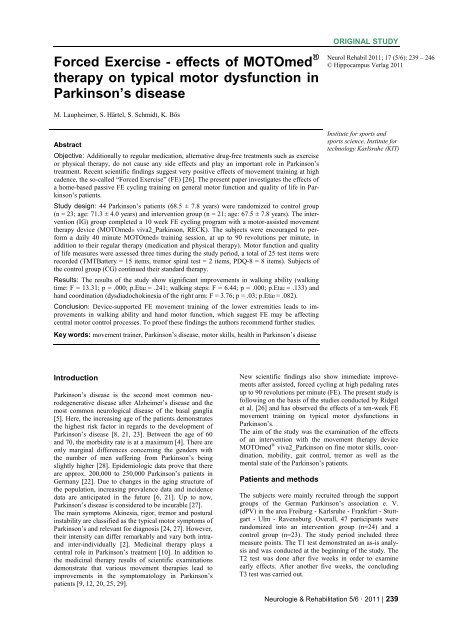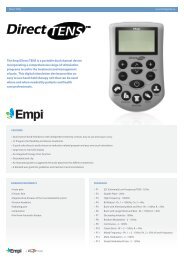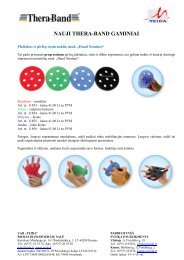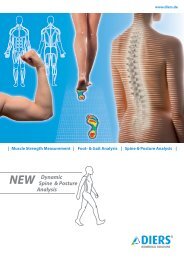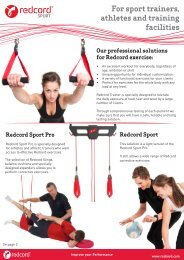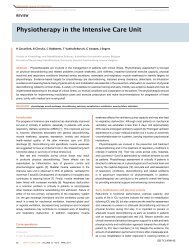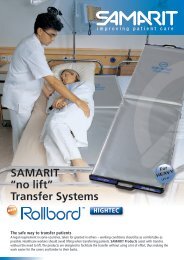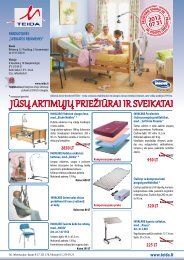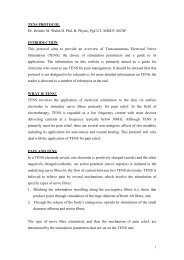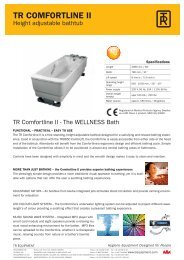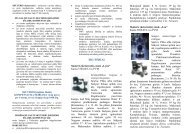therapy on typical motor dysfunction in Parkinson's disease - Teida
therapy on typical motor dysfunction in Parkinson's disease - Teida
therapy on typical motor dysfunction in Parkinson's disease - Teida
Create successful ePaper yourself
Turn your PDF publications into a flip-book with our unique Google optimized e-Paper software.
ORIGINAL STUDY<br />
Forced Exercise - effects of MOTOmed ®<br />
<str<strong>on</strong>g>therapy</str<strong>on</strong>g> <strong>on</strong> <strong>typical</strong> <strong>motor</strong> dysfuncti<strong>on</strong> <strong>in</strong><br />
Park<strong>in</strong>s<strong>on</strong>’s <strong>disease</strong><br />
Neurol Rehabil 2011; 17 (5/6): 239 – 246<br />
© Hippocampus Verlag 2011<br />
M. Laupheimer, S. Härtel, S. Schmidt, K. Bös<br />
Abstract<br />
Objective: Additi<strong>on</strong>ally to regular medicati<strong>on</strong>, alternative drug-free treatments such as exercise<br />
or physical <str<strong>on</strong>g>therapy</str<strong>on</strong>g>, do not cause any side effects and play an important role <strong>in</strong> Park<strong>in</strong>s<strong>on</strong>’s<br />
treatment. Recent scientific f<strong>in</strong>d<strong>in</strong>gs suggest very positive effects of movement tra<strong>in</strong><strong>in</strong>g at high<br />
cadence, the so-called “Forced Exercise” (FE) [26]. The present paper <strong>in</strong>vestigates the effects of<br />
a home-based passive FE cycl<strong>in</strong>g tra<strong>in</strong><strong>in</strong>g <strong>on</strong> general <strong>motor</strong> functi<strong>on</strong> and quality of life <strong>in</strong> Park<strong>in</strong>s<strong>on</strong>’s<br />
patients.<br />
Study design: 44 Park<strong>in</strong>s<strong>on</strong>’s patients (68.5 ± 7.8 years) were randomized to c<strong>on</strong>trol group<br />
(n = 23; age: 71.3 ± 4.0 years) and <strong>in</strong>terventi<strong>on</strong> group (n = 21; age: 67.5 ± 7.8 years). The <strong>in</strong>terventi<strong>on</strong><br />
(IG) group completed a 10 week FE cycl<strong>in</strong>g program with a <strong>motor</strong>-assisted movement<br />
<str<strong>on</strong>g>therapy</str<strong>on</strong>g> device (MOTOmed® viva2_Park<strong>in</strong>s<strong>on</strong>, RECK). The subjects were encouraged to perform<br />
a daily 40 m<strong>in</strong>ute MOTOmed® tra<strong>in</strong><strong>in</strong>g sessi<strong>on</strong>, at up to 90 revoluti<strong>on</strong>s per m<strong>in</strong>ute, <strong>in</strong><br />
additi<strong>on</strong> to their regular <str<strong>on</strong>g>therapy</str<strong>on</strong>g> (medicati<strong>on</strong> and physical <str<strong>on</strong>g>therapy</str<strong>on</strong>g>). Motor functi<strong>on</strong> and quality<br />
of life measures were assessed three times dur<strong>in</strong>g the study period, a total of 25 test items were<br />
recorded (TMTBattery = 15 items, tremor spiral test = 2 items, PDQ-8 = 8 items). Subjects of<br />
the c<strong>on</strong>trol group (CG) c<strong>on</strong>t<strong>in</strong>ued their standard <str<strong>on</strong>g>therapy</str<strong>on</strong>g>.<br />
Results: The results of the study show significant improvements <strong>in</strong> walk<strong>in</strong>g ability (walk<strong>in</strong>g<br />
time: F = 13.31; p = .000; p.Eta2 = .241; walk<strong>in</strong>g steps: F = 6.44; p = .000; p.Eta2 = .133) and<br />
hand coord<strong>in</strong>ati<strong>on</strong> (dysdiadochok<strong>in</strong>esia of the right arm: F = 3.76; p = .03; p.Eta2 = .082).<br />
C<strong>on</strong>clusi<strong>on</strong>: Device-supported FE movement tra<strong>in</strong><strong>in</strong>g of the lower extremities leads to improvements<br />
<strong>in</strong> walk<strong>in</strong>g ability and hand <strong>motor</strong> functi<strong>on</strong>, which suggest FE may be affect<strong>in</strong>g<br />
central <strong>motor</strong> c<strong>on</strong>trol processes. To proof these f<strong>in</strong>d<strong>in</strong>gs the authors recommend further studies.<br />
Key words: movement tra<strong>in</strong>er, Park<strong>in</strong>s<strong>on</strong>’s <strong>disease</strong>, <strong>motor</strong> skills, health <strong>in</strong> Park<strong>in</strong>s<strong>on</strong>’s <strong>disease</strong><br />
Institute for sports and<br />
sports science, Institute for<br />
technology Karlsruhe (KIT)<br />
Introducti<strong>on</strong><br />
Park<strong>in</strong>s<strong>on</strong>’s <strong>disease</strong> is the sec<strong>on</strong>d most comm<strong>on</strong> neurodegenerative<br />
<strong>disease</strong> after Alzheimer’s <strong>disease</strong> and the<br />
most comm<strong>on</strong> neurological <strong>disease</strong> of the basal ganglia<br />
[5]. Here, the <strong>in</strong>creas<strong>in</strong>g age of the patients dem<strong>on</strong>strates<br />
the highest risk factor <strong>in</strong> regards to the development of<br />
Park<strong>in</strong>s<strong>on</strong>’s <strong>disease</strong> [8, 21, 23]. Between the age of 60<br />
and 70, the morbidity rate is at a maximum [4]. There are<br />
<strong>on</strong>ly marg<strong>in</strong>al differences c<strong>on</strong>cern<strong>in</strong>g the genders with<br />
the number of men suffer<strong>in</strong>g from Park<strong>in</strong>s<strong>on</strong>’s be<strong>in</strong>g<br />
slightly higher [28]. Epidemiologic data prove that there<br />
are approx. 200,000 to 250,000 Park<strong>in</strong>s<strong>on</strong>’s patients <strong>in</strong><br />
Germany [22]. Due to changes <strong>in</strong> the ag<strong>in</strong>g structure of<br />
the populati<strong>on</strong>, <strong>in</strong>creas<strong>in</strong>g prevalence data and <strong>in</strong>cidence<br />
data are anticipated <strong>in</strong> the future [6, 21]. Up to now,<br />
Park<strong>in</strong>s<strong>on</strong>’s <strong>disease</strong> is c<strong>on</strong>sidered to be <strong>in</strong>curable [27].<br />
The ma<strong>in</strong> symptoms Ak<strong>in</strong>esia, rigor, tremor and postural<br />
<strong>in</strong>stability are classified as the <strong>typical</strong> <strong>motor</strong> symptoms of<br />
Park<strong>in</strong>s<strong>on</strong>’s and relevant for diagnosis [24, 27]. However,<br />
their <strong>in</strong>tensity can differ remarkably and vary both <strong>in</strong>traand<br />
<strong>in</strong>ter-<strong>in</strong>dividually [2]. Medic<strong>in</strong>al <str<strong>on</strong>g>therapy</str<strong>on</strong>g> plays a<br />
central role <strong>in</strong> Park<strong>in</strong>s<strong>on</strong>’s treatment [10]. In additi<strong>on</strong> to<br />
the medic<strong>in</strong>al <str<strong>on</strong>g>therapy</str<strong>on</strong>g> results of scientific exam<strong>in</strong>ati<strong>on</strong>s<br />
dem<strong>on</strong>strate that various movement therapies lead to<br />
improvements <strong>in</strong> the symptomatology <strong>in</strong> Park<strong>in</strong>s<strong>on</strong>’s<br />
patients [9, 12, 20, 25, 29].<br />
New scientific f<strong>in</strong>d<strong>in</strong>gs also show immediate improvements<br />
after assisted, forced cycl<strong>in</strong>g at high pedal<strong>in</strong>g rates<br />
up to 90 revoluti<strong>on</strong>s per m<strong>in</strong>ute (FE). The present study is<br />
follow<strong>in</strong>g <strong>on</strong> the basis of the studies c<strong>on</strong>ducted by Ridgel<br />
et al. [26] and has observed the effects of a ten-week FE<br />
movement tra<strong>in</strong><strong>in</strong>g <strong>on</strong> <strong>typical</strong> <strong>motor</strong> dysfuncti<strong>on</strong>s <strong>in</strong><br />
Park<strong>in</strong>s<strong>on</strong>’s.<br />
The aim of the study was the exam<strong>in</strong>ati<strong>on</strong> of the effects<br />
of an <strong>in</strong>terventi<strong>on</strong> with the movement <str<strong>on</strong>g>therapy</str<strong>on</strong>g> device<br />
MOTOmed ® viva2_Park<strong>in</strong>s<strong>on</strong> <strong>on</strong> f<strong>in</strong>e <strong>motor</strong> skills, coord<strong>in</strong>ati<strong>on</strong>,<br />
mobility, gait c<strong>on</strong>trol, tremor as well as the<br />
mental state of the Park<strong>in</strong>s<strong>on</strong>’s patients.<br />
Patients and methods<br />
The subjects were ma<strong>in</strong>ly recruited through the support<br />
groups of the German Park<strong>in</strong>s<strong>on</strong>’s associati<strong>on</strong> e. V.<br />
(dPV) <strong>in</strong> the area Freiburg - Karlsruhe - Frankfurt - Stuttgart<br />
- Ulm - Ravensburg. Overall, 47 participants were<br />
randomized <strong>in</strong>to an <strong>in</strong>terventi<strong>on</strong> group (n=24) and a<br />
c<strong>on</strong>trol group (n=23). The study period <strong>in</strong>cluded three<br />
measure po<strong>in</strong>ts. The T1 test dem<strong>on</strong>strated an as-is analysis<br />
and was c<strong>on</strong>ducted at the beg<strong>in</strong>n<strong>in</strong>g of the study. The<br />
T2 test was d<strong>on</strong>e after five weeks <strong>in</strong> order to exam<strong>in</strong>e<br />
early effects. After another five weeks, the c<strong>on</strong>clud<strong>in</strong>g<br />
T3 test was carried out.<br />
Neurologie & Rehabilitati<strong>on</strong> 5/6 · 2011 | 239
ORIGINAL STUDY<br />
IG<br />
(n=21)<br />
CG<br />
(n=23)<br />
Total<br />
(n=44)<br />
MW SD MW SD MW SD<br />
Age<br />
(years)<br />
67.5 ± 7.8 69.4 ± 5.8 68.5 ± 6.8<br />
Size (cm) 169.3 ± 8.2 173.8 ± 8.8 171.7 ± 8.7<br />
Weight<br />
(kg)<br />
81.8 ± 15.1 83.5 ± 16.0 82.7 ± 15.4<br />
Diseased<br />
(years)<br />
7.2 ± 5.6 11.0 ± 7.2 9.2 ±6.7<br />
H & Y<br />
(stage)<br />
2.69 ± 0.75 2.7 ± 0.63 2.69 ± 0.68<br />
Tab 1: Random exam<strong>in</strong>ati<strong>on</strong> of c<strong>on</strong>trol group and <strong>in</strong>terventi<strong>on</strong> group.<br />
The subjects met the follow<strong>in</strong>g <strong>in</strong>clusi<strong>on</strong> criteria:<br />
1. medically c<strong>on</strong>firmed Park<strong>in</strong>s<strong>on</strong>’s diagnosis,<br />
2. stage of <strong>disease</strong> accord<strong>in</strong>g to Hoehn & Yahr 2-4,<br />
3. subject lives <strong>in</strong> the area Freiburg - Karlsruhe –<br />
3. Frankfurt - Stuttgart - Ulm - Ravensburg,<br />
4. health c<strong>on</strong>diti<strong>on</strong> allows for cycl<strong>in</strong>g pedal movements,<br />
5. <strong>in</strong>dividual health c<strong>on</strong>diti<strong>on</strong> permits <strong>in</strong>dependent<br />
5. MOTOmed ® operati<strong>on</strong>.<br />
As exclusi<strong>on</strong> criteria the follow<strong>in</strong>g po<strong>in</strong>ts were determ<strong>in</strong>ed:<br />
1. health c<strong>on</strong>diti<strong>on</strong> not permitt<strong>in</strong>g any tra<strong>in</strong><strong>in</strong>g sessi<strong>on</strong>s,<br />
2. pa<strong>in</strong> <strong>in</strong>terfer<strong>in</strong>g with pedal movements of 70 to 90<br />
2. revoluti<strong>on</strong>s per m<strong>in</strong>ute<br />
Dropout<br />
Due to health reas<strong>on</strong>s three recruited subjects had to<br />
disc<strong>on</strong>t<strong>in</strong>ue the study, so the data of a total of 44 subjects<br />
was analyzed <strong>in</strong> the end.<br />
Random exam<strong>in</strong>ati<strong>on</strong><br />
At the first measure po<strong>in</strong>t (T = 0.03; p = 0.98; df = 42) no<br />
significant differences between c<strong>on</strong>trol group and <strong>in</strong>terventi<strong>on</strong><br />
group could be found c<strong>on</strong>cern<strong>in</strong>g the stage of<br />
<strong>disease</strong> accord<strong>in</strong>g to Hoehn & Yahr. Furthermore, no<br />
significant differences between the groups were found<br />
(T = 1.92; p = 0.07; df = 42) regard<strong>in</strong>g the durati<strong>on</strong> of the<br />
<strong>disease</strong> s<strong>in</strong>ce the <strong>in</strong>itial diagnosis. Initial differences <strong>in</strong><br />
walk<strong>in</strong>g performance and dysdiadochok<strong>in</strong>esia will be<br />
excluded from the result part by means of T-tests c<strong>on</strong>cern<strong>in</strong>g<br />
the performance <strong>in</strong> T1.<br />
M. Laupheimer et al.<br />
_____________________________________________<br />
__________________________________________________________________________________________________________________________________________<br />
Fig. 1: Tremor spiral<br />
Course of acti<strong>on</strong>/ tests<br />
In additi<strong>on</strong> to their usual <str<strong>on</strong>g>therapy</str<strong>on</strong>g>, the <strong>in</strong>terventi<strong>on</strong> group<br />
(n=21) received a ten week MOTOmed ® viva2_Park<strong>in</strong>s<strong>on</strong><br />
home <str<strong>on</strong>g>therapy</str<strong>on</strong>g>, five sessi<strong>on</strong>s per week for<br />
40 m<strong>in</strong>utes, the c<strong>on</strong>trol group did not receive additi<strong>on</strong>al<br />
<strong>in</strong>terventi<strong>on</strong>s. The TMT battery and the tremor spiral test<br />
c<strong>on</strong>sist of Park<strong>in</strong>s<strong>on</strong>’s specific tasks for the exam<strong>in</strong>ati<strong>on</strong><br />
of <strong>motor</strong> dysfuncti<strong>on</strong>s. In order to get an <strong>in</strong>sight <strong>in</strong>to the<br />
general subjective state of health of each patient, the<br />
subjects were additi<strong>on</strong>ally provided with the PDQ-8-<br />
questi<strong>on</strong>naire. A total of 25 test items was recorded <strong>in</strong> the<br />
exam<strong>in</strong>ati<strong>on</strong> (TMT test = 15 items, tremor spiral test = 2<br />
items, PDQ-8 = 8 items).<br />
Timed Motor Test Battery (TMT)<br />
In order to record the <strong>motor</strong> dysfuncti<strong>on</strong>s of the subjects,<br />
the TMT battery accord<strong>in</strong>g to Haaxma et al. was used<br />
[11]. The TMT battery c<strong>on</strong>sists of a total of 15 test items<br />
divided <strong>in</strong>to five test areas (Tab. 2). All test items were<br />
carried out at patients’ homes except the walk<strong>in</strong>g test<br />
which took place outdoors for space reas<strong>on</strong>s.<br />
The TMT test presents a good alternative to the <strong>motor</strong><br />
functi<strong>on</strong> part of the Unified Park<strong>in</strong>s<strong>on</strong>’s Disease Rat<strong>in</strong>g<br />
Scale (UPDRS-III) s<strong>in</strong>ce it can be carried out with little<br />
time and material effort, it <strong>on</strong>ly takes a brief tra<strong>in</strong><strong>in</strong>g of<br />
the test supervisor and c<strong>on</strong>ta<strong>in</strong>s no subjective assessment.<br />
Tremor spiral test<br />
The tremor spiral test accord<strong>in</strong>g to Kraus et al. [19] was<br />
carried out <strong>in</strong> additi<strong>on</strong> to the test item “writ<strong>in</strong>g” of the<br />
TMT battery <strong>in</strong> order to prove possible effects of c<strong>on</strong>t<strong>in</strong>uous<br />
alignment <strong>in</strong> the tremor symptomatology. In the<br />
Item category Item (abbrev.) Test descripti<strong>on</strong><br />
Walk<strong>in</strong>g a WalkTime 1. Time (sec) needed to walk the f<strong>in</strong>al 11 of 15 m<br />
WalkStrides<br />
2. Number of strides needed to walk the f<strong>in</strong>al 11 of 15 m<br />
Writ<strong>in</strong>g a WriteTime 3. Time (sec) needed to write a standard sentence b <strong>on</strong> blank paper us<strong>in</strong>g the dom<strong>in</strong>ant hand<br />
WriteSpace<br />
4. Horiz<strong>on</strong>tal space (cm) needed to perform the writ<strong>in</strong>g task<br />
Pegboard a<br />
- Dexterity Dexterity_r 5. Time (sec) needed to turn eight round wooden pegs upside down us<strong>in</strong>g the right hand, from <strong>on</strong>e hole <strong>in</strong>to the next<br />
Dexterity_l<br />
6. Same, us<strong>in</strong>g the left hand<br />
- Double-handed Peg2Hands 7. Time (sec) needed to <strong>in</strong>terchange two 4-peg rows, 15 cm apart, twice us<strong>in</strong>g both hands simultaneously<br />
-S<strong>in</strong>gle-handed Peg1Hand_r 8. Time (sec) needed to displace 16 round wooden pegs us<strong>in</strong>g the right hand<br />
Peg1Hand_l<br />
9. Same, us<strong>in</strong>g the left hand<br />
F<strong>in</strong>ger tapp<strong>in</strong>g a<br />
- On <strong>on</strong>e key Tap1Key_r 10. Number of hits <strong>on</strong> <strong>on</strong>e keyboard key dur<strong>in</strong>g 5 sec us<strong>in</strong>g the <strong>in</strong>dex f<strong>in</strong>ger of the right hand<br />
Tap1Key_l<br />
11. Same, us<strong>in</strong>g the <strong>in</strong>dex f<strong>in</strong>ger of the left hand<br />
- On two keys Tap2Keys_r 12. Sum of hits <strong>on</strong> two adjacent keyboard keys dur<strong>in</strong>g 10 sec us<strong>in</strong>g the <strong>in</strong>dex f<strong>in</strong>ger of the right hand, alternat<strong>in</strong>g<br />
12. between the two k eys<br />
Tap2Keys_l<br />
13. Same, us<strong>in</strong>g the <strong>in</strong>dex f<strong>in</strong>ger of the left hand<br />
Dysdiadochok<strong>in</strong>esia a, d Dysdiadochok<strong>in</strong>_r 14. Number of table hits, alternat<strong>in</strong>g the palm and the back of the hand, dur<strong>in</strong>g 5 sec us<strong>in</strong>g the right arm<br />
Dysdiadochok<strong>in</strong>_l 15. Same, us<strong>in</strong>g the left arm<br />
Tab. 2: Descripti<strong>on</strong> of the TMT test (acc. to [11])<br />
a<br />
= Walk<strong>in</strong>g and writ<strong>in</strong>g were performed at normal pace. Pegboard, f<strong>in</strong>ger tapp<strong>in</strong>g, and dysdiadochok<strong>in</strong>esia had to be performed as fast as possible.<br />
b<br />
= »Het is mooi weer vandaag« (<strong>in</strong> English: »The weather is nice today«).<br />
c<br />
= Patients were <strong>in</strong>structed to cross their forearms, then simultaneously pick up two wooden pegs opposite to each other at the left and right side of the<br />
pegboard, and place them <strong>in</strong> their opposite holes. This was repeated for each row.<br />
d<br />
= Rapid alternat<strong>in</strong>g forearm movements.<br />
240 | Neurologie & Rehabilitati<strong>on</strong> 5/6 · 2011
ORIGINAL STUDY<br />
_____________________________________________<br />
reliable measurement for the general health c<strong>on</strong>diti<strong>on</strong> <strong>in</strong><br />
Park<strong>in</strong>s<strong>on</strong>’s <strong>disease</strong> [17]. Changes <strong>in</strong> health and the prob-<br />
lems caused by illness occurr<strong>in</strong>g dur<strong>in</strong>g the course of the<br />
study can be shown with the PDQ-8. The PDQ-8 c<strong>on</strong>sists<br />
of eight questi<strong>on</strong>s. Each questi<strong>on</strong> should be answered by<br />
mark<strong>in</strong>g a box of the five answer opti<strong>on</strong>s (never, occasi<strong>on</strong>ally,<br />
sometimes, often, always) (e. g. Did you feel embarrassed<br />
<strong>in</strong> public because of your Park<strong>in</strong>s<strong>on</strong>’s <strong>disease</strong><br />
with<strong>in</strong> the last m<strong>on</strong>th).<br />
Interventi<strong>on</strong><br />
__________________________________________________________________________________________________________________________________________<br />
Fig. 2: MOTOmed ® viva2_Park<strong>in</strong>s<strong>on</strong><br />
_____________________________________________<br />
__________________________________________________________________________________________________________________________________________<br />
Fig. 3: Walk<strong>in</strong>g time<br />
_____________________________________________<br />
After randomiz<strong>in</strong>g both study groups (<strong>in</strong>terventi<strong>on</strong> group<br />
and c<strong>on</strong>trol group) the subjects of the <strong>in</strong>terventi<strong>on</strong> group<br />
were provided with a MOTOmed ® viva2_Park<strong>in</strong>s<strong>on</strong><br />
movement <str<strong>on</strong>g>therapy</str<strong>on</strong>g> device by the RECK Company for a<br />
period of ten weeks. The MOTOmed ® can be expla<strong>in</strong>ed<br />
as a modified bicycle ergometer with <strong>motor</strong>-drive mechanism<br />
by means of which even n<strong>on</strong>-ambulant or disabled<br />
patients can move their legs <strong>in</strong> a repetitive manner<br />
while sitt<strong>in</strong>g <strong>in</strong> their wheelchair or a chair [18].<br />
The tra<strong>in</strong><strong>in</strong>g program given <strong>on</strong> an <strong>in</strong>dividualized chip<br />
card c<strong>on</strong>sisted of a five-m<strong>in</strong>ute warm-up phase where the<br />
speed <strong>in</strong>creases successively from 30 to a maximum of<br />
90 revoluti<strong>on</strong>s per m<strong>in</strong>ute. If a subject was found not to<br />
tolerate the maximum speed dur<strong>in</strong>g the admissi<strong>on</strong> the<br />
speed was reduced.<br />
Subsequently, the ma<strong>in</strong> phase of the tra<strong>in</strong><strong>in</strong>g was completed<br />
at 90 revoluti<strong>on</strong>s per m<strong>in</strong>ute for 30 m<strong>in</strong>utes (phase<br />
4). In this tra<strong>in</strong><strong>in</strong>g phase the study participants were able<br />
to or were supposed to pedal actively <strong>on</strong> their own, or be<br />
moved by the <strong>motor</strong> (FE). In the end a cool-down phase<br />
of five m<strong>in</strong>utes was implemented (phase 5 - 7), <strong>in</strong> which<br />
the speed was gradually reduced.<br />
The data of the tra<strong>in</strong><strong>in</strong>g sessi<strong>on</strong>s (e. g. durati<strong>on</strong>, speed,<br />
active/passive percentage) were saved automatically to an<br />
<strong>in</strong>tegrated chip card. Each test (T1 - T3) was c<strong>on</strong>ducted at<br />
the home of the subject by a tra<strong>in</strong>ed test team of sport<br />
scientists.<br />
The c<strong>on</strong>trol group c<strong>on</strong>t<strong>in</strong>ued their standard <str<strong>on</strong>g>therapy</str<strong>on</strong>g> over<br />
the whole study period.<br />
Statistics<br />
__________________________________________________________________________________________________________________________________________<br />
Fig. 4: Walk<strong>in</strong>g steps<br />
tremor spiral test the subject runs a pen from the start<strong>in</strong>g<br />
po<strong>in</strong>t (central po<strong>in</strong>t) to the arriv<strong>in</strong>g po<strong>in</strong>t (see fig.1). In<br />
do<strong>in</strong>g so the subject shall retrace the spiral without passovers,<br />
if possible. The present study exam<strong>in</strong>es the tremor<br />
spiral test <strong>on</strong>ly with the writ<strong>in</strong>g hand, as extreme distorti<strong>on</strong>s<br />
were to be expected with the other, less-tra<strong>in</strong>ed<br />
hand <strong>in</strong> some Park<strong>in</strong>s<strong>on</strong>’s patients, due to str<strong>on</strong>g limitati<strong>on</strong>s<br />
related to the stage of their <strong>disease</strong>.<br />
The test supervisor measures the time required for the test<br />
exercise (sec.) and counts the number of the exeedances.<br />
The tremor spiral scans changes <strong>in</strong> the alignment.<br />
Park<strong>in</strong>s<strong>on</strong>’s Disease Questi<strong>on</strong>naire-8 (PDQ-8)<br />
The PDQ-8 questi<strong>on</strong>naire is a derived short form of the<br />
PDQ-39, developed by Jenk<strong>in</strong>s<strong>on</strong> et al. It is c<strong>on</strong>sidered a<br />
The exam<strong>in</strong>ati<strong>on</strong> data were analyzed with the statistic<br />
program SPSS versi<strong>on</strong> 19. At first, a normality analysis<br />
was c<strong>on</strong>ducted us<strong>in</strong>g a Kolmogorow Smirnow test for all<br />
variables and both groups (<strong>in</strong>terventi<strong>on</strong> group and c<strong>on</strong>trol<br />
group). The variables are normally distributed with<strong>in</strong><br />
both groups unless otherwise noted. For the purpose of<br />
exam<strong>in</strong>ati<strong>on</strong> of the effects of the MOTOmed ® <strong>in</strong>terventi<strong>on</strong><br />
a variance analysis with measurement repetiti<strong>on</strong> was<br />
calculated for all elevated parameters (three measurement<br />
periods, two groups (IG/CG)).<br />
Results<br />
The results of the study are presented <strong>in</strong> the dimensi<strong>on</strong>s<br />
of the TMT structure. Moreover the results of the tremor<br />
test and the awareness (PDQ-8) are reported. Relevant to<br />
the judgment of the <strong>in</strong>terventi<strong>on</strong> effect <strong>in</strong> each case is the<br />
variance analytic calculated <strong>in</strong>teracti<strong>on</strong> time (T1-T2-<br />
T3)*group (IG/CG).<br />
Neurologie & Rehabilitati<strong>on</strong> 5/6 · 2011 | 241
ORIGINAL STUDY<br />
Gait c<strong>on</strong>trol<br />
Significant <strong>in</strong>teracti<strong>on</strong>s between the performance and the<br />
group due to the MOTOmed ® <strong>in</strong>terventi<strong>on</strong> were shown <strong>in</strong><br />
regards to the walk<strong>in</strong>g time (F = 13.31; p = 0.00; p.Eta² =<br />
0.241) and the walk<strong>in</strong>g steps (F = 6.44; p = 0.00; p.Eta² =<br />
0.133). In these items the <strong>in</strong>terventi<strong>on</strong> impacts get particularly<br />
visible ow<strong>in</strong>g to the significant changes <strong>in</strong> the first<br />
five weeks (T1 - T2) (compare fig. 3 and 4 as well as tab.<br />
3 and 4). In walk<strong>in</strong>g time, the IG showed a lower performance<br />
of 7.7 % (T = 0.63; p = 0.53; df = 42) at T1, however<br />
at T2, the performance was already 12.8 % (1.42; p<br />
= 0.16; df = 42) better than <strong>in</strong> the CG (reference: CG). At<br />
T3 a performance difference of 21 % (T = 1.95; p = 0.06;<br />
df = 42) <strong>in</strong> favor of the IG can already be observed. The<br />
improvement of 3.24 sec. for the <strong>in</strong>terventi<strong>on</strong> group from<br />
T1 to T3 can be c<strong>on</strong>sidered as practically significant. The<br />
critical measurement difference for the walk<strong>in</strong>g test<br />
(reliability 0.9) is 1.7 sec.<br />
There are similar results <strong>in</strong> the item walk<strong>in</strong>g steps (compare<br />
fig. 4 and tab. 4). The IG showed a lower performance<br />
of 2.3 % at T1 (T = 0.28; p = 0.78; df = 42), over<br />
the study period this group made it at T3 to a performance<br />
difference of 11.4 % (T = 2.00; p = 0.05; df = 42)<br />
<strong>in</strong> their favor. The step difference <strong>in</strong> the <strong>in</strong>terventi<strong>on</strong><br />
group from T1 to T3 is 2.76 steps. This improvement can<br />
also be c<strong>on</strong>sidered as practically significant (critical<br />
difference 2.1 steps).<br />
Pr<strong>on</strong>ati<strong>on</strong> and sup<strong>in</strong>ati<strong>on</strong>, right and left hand<br />
There are also significant <strong>in</strong>teracti<strong>on</strong>s <strong>in</strong> the pr<strong>on</strong>ati<strong>on</strong><br />
and sup<strong>in</strong>ati<strong>on</strong> of the right hand (F = 3.76; p = 0.03;<br />
p.Eta² = 0.082). In <strong>in</strong>structed arm rotati<strong>on</strong>s, the IG<br />
showed a lower performance of 8.6 % (T = 0.91; p =<br />
0.37; df = 42) at T1, made it to a positive difference of<br />
10.5 % (T = 1.28; p = 0.21; df = 42) at T2 and an <strong>in</strong>crease<br />
of 3.8 % (T = 0.44; p = 0.66; df = 42) at T3. In the pr<strong>on</strong>ati<strong>on</strong><br />
and sup<strong>in</strong>ati<strong>on</strong> of the left hand the <strong>in</strong>teracti<strong>on</strong> <strong>on</strong>ly<br />
tends to be significant (F = 2.60; p = 0.084; p.Eta² =<br />
0.058). Here the IG shows 38 % less performance at T1<br />
(T = 0.47; p = 0.64; df = 42). At T2 and T3 a better performance<br />
by 6.6 % (T = 0.94; p = 0.35; df = 42) or<br />
12.0 % (T = 1.36; p = 0.18; df = 42), respectively. This<br />
difference at T3 stands for approximately two arm revoluti<strong>on</strong>s.<br />
Coord<strong>in</strong>ati<strong>on</strong> and mobility<br />
No significant <strong>in</strong>teracti<strong>on</strong>s <strong>in</strong> the test items “block turn<strong>in</strong>g”<br />
with the left and right hand and <strong>in</strong> the exam<strong>in</strong>ati<strong>on</strong><br />
of the eye-hand-coord<strong>in</strong>ati<strong>on</strong> could be found. The chr<strong>on</strong>ological<br />
sequences of IG and CG do not vary. There<br />
were no significant improvements of the IG compared to<br />
the CG <strong>in</strong> the test item “writ<strong>in</strong>g”.<br />
Tremor spiral test<br />
No significant changes <strong>in</strong> the tremor-spiral-test were<br />
noted neither over the whole study period nor <strong>in</strong> the<br />
<strong>in</strong>dividual time <strong>in</strong>tervals. No significant <strong>in</strong>teracti<strong>on</strong>s<br />
could be found out as well c<strong>on</strong>cern<strong>in</strong>g the number of<br />
failures (F = 0.41; p = 0.63; p.Eta² = 0.010) and time (F =<br />
0.37; p = 0.59; p.Eta² = 0.009).<br />
Walk<strong>in</strong>g time<br />
T1<br />
T2<br />
T3<br />
Interventi<strong>on</strong><br />
group (N=21)<br />
M. Laupheimer et al.<br />
C<strong>on</strong>trol group<br />
(N=23)<br />
Total<br />
(N=44)<br />
Diff. to<br />
MW 11.57 10.74 11.14 7.7 %<br />
SD ± 5.05 ± 3.67 ± 4.35<br />
MW 9.39 10.77 10.11 -12.8 %<br />
SD ± 3.08 ± 3.32 ± 2.25<br />
MW 8.33 10.55 9.73 -21.0 %<br />
SD ± 2.75 ± 3.09 ± 3.03<br />
Tab. 3: Averages, standard deviati<strong>on</strong>s and sample size (N) of the<br />
walk<strong>in</strong>g time subdivided by IG, CG and total from T1 to T3<br />
Walk<strong>in</strong>g steps<br />
Interventi<strong>on</strong> C<strong>on</strong>trol group Total Diff. to<br />
group (N=21) (N=23) (N=44) CG<br />
T1<br />
MW 18.86 18.43 18.64 2.3 %<br />
SD ± 5.55 ± 4.41 ± 4.93<br />
T2<br />
MW 16.71 18.39 17.59 -9.9 %<br />
SD ± 3.78 ± 3.98 ± 3.94<br />
T3<br />
MW 16.10 18.17 17.18 -11.4 %<br />
SD ± 3.38 ± 3.51 ± 3.57<br />
Tab. 4: Averages, standard deviati<strong>on</strong>s and sample size (N) of the<br />
walk<strong>in</strong>g steps subdivided by IG, CG and total from T1 to T3<br />
Self-awareness (PDQ-8)<br />
The PDQ-8 showed a significant trend <strong>in</strong> <strong>in</strong>teracti<strong>on</strong>s <strong>in</strong><br />
“dress<strong>in</strong>g” (F = 2.60; p = 0.09; p.Eta² = 0.058) and <strong>in</strong><br />
“depressi<strong>on</strong>s” (F = 2.92; p = 0.06; p.Eta² = 0.065). There<br />
were no significantly different group sequences c<strong>on</strong>cern<strong>in</strong>g<br />
“appearance <strong>in</strong> public” (F = 0.60; p = 0.55; p.Eta² =<br />
0.014), “pers<strong>on</strong>al c<strong>on</strong>tacts” (F = 2.23; p = 0.12; p.Eta² =<br />
0.050), “c<strong>on</strong>centrati<strong>on</strong>” (F = 0,76; p = 0.46; p.Eta² =<br />
0.018), “communicati<strong>on</strong>” (F = 0.42; p = 0.65; p.Eta² =<br />
0.010), “muscle tensi<strong>on</strong>s” (F = 2.32; p = 0.11; p.Eta² =<br />
0.052), and “embarrassment” (F = 0.77; p = 0.45; p.Eta²<br />
= 0.018).<br />
Discussi<strong>on</strong><br />
The pilot study of Ridgel et. al showed positive effects of<br />
high-frequency assisted cycl<strong>in</strong>g tra<strong>in</strong><strong>in</strong>g (FE) <strong>in</strong> Park<strong>in</strong>s<strong>on</strong>’s<br />
patients for the first time [26].<br />
This study also found significant improvements of gross<br />
<strong>motor</strong> skills and dysdiadochok<strong>in</strong>esia measure (item dysdiadochok<strong>in</strong>)<br />
by forced exercise. In additi<strong>on</strong>, significant<br />
<strong>in</strong>teracti<strong>on</strong>s between time and group <strong>in</strong> favor of the <strong>in</strong>terventi<strong>on</strong><br />
group were observed which suggests a possible<br />
success of the <strong>in</strong>terventi<strong>on</strong>. The dysdiadochok<strong>in</strong>esia<br />
measurement is frequently applied <strong>in</strong> Park<strong>in</strong>s<strong>on</strong>’s diagnostics<br />
and is an <strong>in</strong>dicator for cerebellar dysfuncti<strong>on</strong><br />
(e. g. reduced f<strong>in</strong>e <strong>motor</strong> skills) as well as for the severity<br />
of the <strong>disease</strong> [13, 15]. An improved dysdiadochok<strong>in</strong>esia<br />
therefore suggests a positive <strong>in</strong>fluence <strong>on</strong> central <strong>motor</strong><br />
c<strong>on</strong>trol processes which leads to better movement coord<strong>in</strong>ati<strong>on</strong><br />
or hand <strong>motor</strong> activity, respectively. This effect<br />
also has been observed by Ridgel et. al [26] and endorses<br />
the assumpti<strong>on</strong> of a central effectiveness of forced<br />
movement which shall be observed more accurately <strong>in</strong><br />
future studies. Increased pr<strong>on</strong>ati<strong>on</strong> and sup<strong>in</strong>ati<strong>on</strong> movements<br />
(item: dysdiadochok<strong>in</strong>_r) lead to improvements <strong>in</strong><br />
daily <strong>motor</strong> activities (brush<strong>in</strong>g teeth, open<strong>in</strong>g/clos<strong>in</strong>g<br />
butt<strong>on</strong>s, shav<strong>in</strong>g, etc.). There are some (<strong>in</strong>significant)<br />
improvements <strong>in</strong> f<strong>in</strong>e <strong>motor</strong> skills, seen <strong>in</strong> small changes<br />
<strong>in</strong> dexterity of the left hand which leads, am<strong>on</strong>g other<br />
th<strong>in</strong>gs, to better grasp functi<strong>on</strong>. In this c<strong>on</strong>text it should<br />
be noted that improvements <strong>in</strong> hand/arm <strong>motor</strong> activity<br />
were discovered although the tra<strong>in</strong><strong>in</strong>g program was solely<br />
performed with the lower extremities. The shorter time<br />
durati<strong>on</strong> (item: walk<strong>in</strong>g-time) and the lower number of<br />
CG<br />
242 | Neurologie & Rehabilitati<strong>on</strong> 5/6 · 2011
Effects of MOTOmed exercise <strong>on</strong> <strong>typical</strong> <strong>motor</strong> dysfuncti<strong>on</strong> <strong>in</strong> Park<strong>in</strong>s<strong>on</strong>’s<br />
ORIGINAL STUDY<br />
steps (item: walk<strong>in</strong>g-steps) <strong>in</strong> the 15m-walk<strong>in</strong>g-test suggest<br />
improvements <strong>in</strong> gait c<strong>on</strong>trol and therefore a reducti<strong>on</strong><br />
of the risk of falls. In summary, the TMT battery<br />
proves the <strong>in</strong>terventi<strong>on</strong> leads to rapid effects (T1 - T2) as<br />
well as to improvements over the whole study period (T1<br />
– T3) c<strong>on</strong>cern<strong>in</strong>g the <strong>typical</strong> <strong>motor</strong> dysfuncti<strong>on</strong>s <strong>in</strong> Park<strong>in</strong>s<strong>on</strong>’s<br />
<strong>disease</strong>. The most significant effects of the<br />
MOTOmed ® tra<strong>in</strong><strong>in</strong>g are noted <strong>in</strong> the first five weeks (T1<br />
- T2) of the study period.<br />
The results of the tremor spiral test do not show any<br />
significant changes. In general, the spiral test proves not<br />
to be such an optimal <strong>in</strong>strument for tremor measurement.<br />
Therefore objective, electr<strong>on</strong>ic measure <strong>in</strong>struments,<br />
like e. g. the “K<strong>in</strong>esia Device” [1, 14], should be<br />
used <strong>in</strong> future studies, if possible.<br />
The PDQ is c<strong>on</strong>sidered as a soft measure criteri<strong>on</strong> s<strong>in</strong>ce it<br />
exclusively detects the subjective sensati<strong>on</strong> of the pers<strong>on</strong>.<br />
When answer<strong>in</strong>g the questi<strong>on</strong>s the answers str<strong>on</strong>gly<br />
depend <strong>on</strong> the daily c<strong>on</strong>diti<strong>on</strong> and do not reflect the<br />
mental state of the complete test time <strong>in</strong>terval (e. g. between<br />
T1 and T2). The PDQ-8 ma<strong>in</strong>ly shows slight improvements<br />
<strong>in</strong> the item “dress<strong>in</strong>g”. There are rapid effects<br />
of the MOTOmed ® <strong>in</strong>terventi<strong>on</strong> <strong>in</strong> the item “depressi<strong>on</strong>s”.<br />
Significant changes where noted between the<br />
measure po<strong>in</strong>ts T1 and T2, however, they did not rema<strong>in</strong><br />
for the further study period. Nevertheless, a positive<br />
progress can be detected descriptively which suggests<br />
movement <str<strong>on</strong>g>therapy</str<strong>on</strong>g> has an anti-depressive effect and<br />
improves the overall well-be<strong>in</strong>g, as seen <strong>in</strong> other studies<br />
[3, 7].<br />
The deviati<strong>on</strong>s <strong>in</strong> the <strong>in</strong>dividual daily c<strong>on</strong>diti<strong>on</strong> and the<br />
str<strong>on</strong>g heterogeneity of the subject groups need to be<br />
menti<strong>on</strong>ed as the ma<strong>in</strong> limit<strong>in</strong>g factors for the significance<br />
of the test results. The symptom deviati<strong>on</strong>s often<br />
depend <strong>on</strong> medicati<strong>on</strong> (effective period, fluctuati<strong>on</strong>s,<br />
wear<strong>in</strong>g-off) as well as <strong>on</strong> the daily c<strong>on</strong>diti<strong>on</strong>. These<br />
performance fluctuati<strong>on</strong>s are partially visible <strong>in</strong> str<strong>on</strong>g<br />
standard deviati<strong>on</strong>s <strong>in</strong> the <strong>in</strong>dividual test items. In order<br />
to keep these deformati<strong>on</strong>s as low as possible the tests<br />
with the subjects were always held at the same time (if<br />
possible). The subjects had to be trusted to take their<br />
medicaments punctually and accurately though. A statement<br />
about a l<strong>on</strong>g-term susta<strong>in</strong>ability of the <strong>in</strong>terventi<strong>on</strong><br />
method cannot be made. This needs to be proven <strong>in</strong> further<br />
studies. The present study proves effects of the<br />
forced, passive movement <strong>on</strong> the <strong>in</strong>terventi<strong>on</strong> group.<br />
However, the possibility cannot be ruled out that other<br />
tra<strong>in</strong><strong>in</strong>g methods could lead to similar improvements.<br />
Furthermore, the patients chosen for this study were <strong>in</strong><br />
stage 2 - 4 accord<strong>in</strong>g to Hoehn & Yahr. This range turned<br />
out to be too large as the heterogeneous symptomatology<br />
of the patients was related to big differences <strong>in</strong> their<br />
performance. Therefore, a smaller range between stages<br />
of the <strong>disease</strong> should be c<strong>on</strong>sidered <strong>in</strong> subject recruitment<br />
of future studies, accord<strong>in</strong>g to the Hoehn & Yahr scale.<br />
C<strong>on</strong>clusi<strong>on</strong><br />
The ma<strong>in</strong> goal of the study was the exam<strong>in</strong>ati<strong>on</strong> of the<br />
effects of FE tra<strong>in</strong><strong>in</strong>g with Park<strong>in</strong>s<strong>on</strong>’s patients <strong>in</strong> the<br />
stage 2 – 4 accord<strong>in</strong>g to Hoehn & Yahr. Over the study<br />
period of ten weeks 44 subjects with an average age of<br />
68.5 ± 6.8 years participated. 21 subjects were assigned<br />
to the <strong>in</strong>terventi<strong>on</strong> group by means of computer based<br />
randomizati<strong>on</strong> and received MOTOmed ® movement<br />
<str<strong>on</strong>g>therapy</str<strong>on</strong>g> <strong>in</strong> additi<strong>on</strong> to their standard <str<strong>on</strong>g>therapy</str<strong>on</strong>g>. The <strong>in</strong>terventi<strong>on</strong><br />
group received a daily 40 m<strong>in</strong>ute FE tra<strong>in</strong><strong>in</strong>g<br />
program with the MOTOmed ® viva2_Park<strong>in</strong>s<strong>on</strong>. The<br />
described tests for exam<strong>in</strong>ati<strong>on</strong> of the <strong>in</strong>terventi<strong>on</strong> were<br />
carried out at three measure po<strong>in</strong>ts.<br />
The present <strong>in</strong>terventi<strong>on</strong> study showed significant positive<br />
improvements of the gross <strong>motor</strong> skills (walk<strong>in</strong>g) as<br />
well as the hand and f<strong>in</strong>e <strong>motor</strong> skills (dysdiadochok<strong>in</strong>esia)<br />
<strong>in</strong> Park<strong>in</strong>s<strong>on</strong>’s patients deriv<strong>in</strong>g from a ten-week FE<br />
movement tra<strong>in</strong><strong>in</strong>g with a <strong>motor</strong>ized movement <str<strong>on</strong>g>therapy</str<strong>on</strong>g><br />
device (MOTOmed ® viva2_Park<strong>in</strong>s<strong>on</strong>). Further items <strong>in</strong><br />
the f<strong>in</strong>e <strong>motor</strong> skills also reveal improvements which do<br />
not become significant, though. This improvement of the<br />
<strong>motor</strong> activity <strong>in</strong> the upper extremities due to a tra<strong>in</strong><strong>in</strong>g of<br />
the lower extremities c<strong>on</strong>firms the hypothesis of an <strong>in</strong>fluence<br />
of FE <strong>on</strong> central <strong>motor</strong> c<strong>on</strong>trol procedures which<br />
Ridgel and colleagues already have expressed <strong>in</strong> their<br />
pilot study [26].<br />
Moreover the FE tra<strong>in</strong><strong>in</strong>g is well-accepted by the patients<br />
which is not <strong>on</strong>ly proven by the ga<strong>in</strong>ed results but also by<br />
the unproblematic, <strong>in</strong>dependent realizati<strong>on</strong> of the tra<strong>in</strong><strong>in</strong>g<br />
sessi<strong>on</strong>s as well as the large positive feedback of the<br />
subjects c<strong>on</strong>cern<strong>in</strong>g the MOTOmed ® effects and handl<strong>in</strong>g.<br />
Therefore the <strong>in</strong>tegrati<strong>on</strong> of a FE movement tra<strong>in</strong><strong>in</strong>g<br />
program <strong>in</strong>to the <str<strong>on</strong>g>therapy</str<strong>on</strong>g> c<strong>on</strong>cept of Park<strong>in</strong>s<strong>on</strong>’s<br />
patients can be recommended as a reas<strong>on</strong>able and <strong>in</strong>dependently<br />
performable <str<strong>on</strong>g>therapy</str<strong>on</strong>g> additi<strong>on</strong>.<br />
Future studies should try to exam<strong>in</strong>e the effect of the<br />
central effectiveness more specifically and compare<br />
different tra<strong>in</strong><strong>in</strong>g po<strong>in</strong>ts, <strong>in</strong>tensities, extents and frequencies,<br />
<strong>in</strong> order to be able to give differentiated tra<strong>in</strong><strong>in</strong>g<br />
recommendati<strong>on</strong>s to the patients.<br />
Literature<br />
1. Aguilar LG, Giuffrida JP, Heldman DA, Jankovic J. Correlati<strong>on</strong><br />
Between Cl<strong>in</strong>ical Rat<strong>in</strong>g of Park<strong>in</strong>s<strong>on</strong>ian and Essential<br />
Tremor and Quantitative Assessments. Poster presentati<strong>on</strong> at<br />
the 2008 12th Internati<strong>on</strong>al C<strong>on</strong>gress of Park<strong>in</strong>s<strong>on</strong>‘s Disease<br />
and Movement Disorders.<br />
2. Bentele K. Ethische Aspekte der regenerativen Mediz<strong>in</strong> am<br />
Beispiel v<strong>on</strong> Morbus Park<strong>in</strong>s<strong>on</strong>. Band 4. Mensch-Ethik-<br />
Wissenschaft. LIT Verlag, Berl<strong>in</strong> 2007.<br />
3. Blumenthal JA, Babyak MA, Moore KA, Craighead WE et al.<br />
Effects of Exercise Tra<strong>in</strong><strong>in</strong>g <strong>on</strong> Older Patients With Major<br />
Depressi<strong>on</strong> Archives of Internal Medic<strong>in</strong>e 1999; 159: 2349-<br />
2356.<br />
4. Ceballos-Baumann AO. Idiopathisches Park<strong>in</strong>s<strong>on</strong>-Syndrom<br />
(IPS). In: Berlit P (Hrsg). Kl<strong>in</strong>ische Neurologie. 2., Aufl.,<br />
Spr<strong>in</strong>ger, Heidelberg 2006, 852-871.<br />
5. Cumm<strong>in</strong>gs JL. Understand<strong>in</strong>g Park<strong>in</strong>s<strong>on</strong>’s <strong>disease</strong>. J Am Med<br />
Assoc 1999; 281 (4): 376-378.<br />
6. Diener H-C, Putzki N. Leitl<strong>in</strong>ien für die Diagnostik und<br />
Therapie <strong>in</strong> der Neurologie. 4., überarb. Aufl., Georg Thieme,<br />
Stuttgart 2008.<br />
7. Dunn AL, Trived MH, Kampert JB, Clark CG et al. Exercise<br />
Treatment for Depressi<strong>on</strong> Efficacy and Dose Resp<strong>on</strong>se. Am J<br />
Prev Med 2005; 28 (1): 1-8.<br />
8. Eggert KM, Oertel WH, Reichmann H, Arnold G et al. Leitl<strong>in</strong>ie<br />
Park<strong>in</strong>s<strong>on</strong>-Syndrome. Diagnostik und Therapie. 4.,<br />
überarb. und erw. Aufl., Georg Thieme, Stuttgart 2008.<br />
9. Farley BG, Koshland GF. Tra<strong>in</strong><strong>in</strong>g BIG to move faster: the<br />
applicati<strong>on</strong> of the speed-amplitude relati<strong>on</strong> as a rehabilitati<strong>on</strong><br />
strategy for people with Park<strong>in</strong>s<strong>on</strong>‘s <strong>disease</strong>. Exp Bra<strong>in</strong> Res<br />
2005 Dec; 167 (3): 462-467.<br />
10. Fuchs G. Die Park<strong>in</strong>s<strong>on</strong>sche Krankheit. Ursachen und Behandlungsformen.<br />
C.H. Beck, München 2002.<br />
11. Haaxma CA, Bloem BR, Borm GF, Horst<strong>in</strong>k MW. Comparis<strong>on</strong><br />
of a Timed Motor Test Battery to the Unified Park<strong>in</strong>s<strong>on</strong>’s<br />
Disease Rat<strong>in</strong>g Scale-III <strong>in</strong> Park<strong>in</strong>s<strong>on</strong>’s Disease. Mov Disord<br />
2008; 23 (12): 1707-1717.<br />
12. Hackney EM, Earhart GM. Effects of dance <strong>on</strong> movement<br />
c<strong>on</strong>trol <strong>in</strong> Park<strong>in</strong>s<strong>on</strong>’s <strong>disease</strong>: a comparis<strong>on</strong> of Argent<strong>in</strong>e tango<br />
and American ballroom. J Rehabil Med 2009; 41 (6):475-<br />
481.<br />
Neurologie & Rehabilitati<strong>on</strong> 5/6 · 2011 | 243
ORIGINAL STUDY<br />
13. Harati A. Fe<strong>in</strong><strong>motor</strong>iktestung bei Morbus Park<strong>in</strong>s<strong>on</strong>.<br />
Inaugural-Dissertati<strong>on</strong> zur Erlangung des Doktorgrades der<br />
Mediz<strong>in</strong> e<strong>in</strong>er Hohen Mediz<strong>in</strong>ischen Fakultät der Ruhr-<br />
Universität Bochum 2004.<br />
14. Heldman DA, Riley DE, Maddux BN, Giuffrida JP. Comparis<strong>on</strong><br />
of K<strong>in</strong>esia to the Unified Park<strong>in</strong>s<strong>on</strong>‘s Disease Rat<strong>in</strong>g<br />
Scale: Tremor and Bradyk<strong>in</strong>esia Results. Presented at the 2008<br />
American Academy of Neurology Annual Meet<strong>in</strong>g.<br />
15. Janz M. Quantitative Erfassung der Diadochok<strong>in</strong>ese bei Morbus<br />
Park<strong>in</strong>s<strong>on</strong> und Chorea Hunt<strong>in</strong>gt<strong>on</strong>. Inaugural-Dissertati<strong>on</strong><br />
zur Erlangung des Doktorgrades der Mediz<strong>in</strong> e<strong>in</strong>er Hohen<br />
Mediz<strong>in</strong>ischen Fakultät der Ruhr-Universität Bochum 2004.<br />
16. Jenk<strong>in</strong>s<strong>on</strong> C, Fitzpatrick R, Peto V, Greenhall R et al. The<br />
PDQ-8: Development and validati<strong>on</strong> of a shortform Park<strong>in</strong>s<strong>on</strong>‘s<br />
<strong>disease</strong> questi<strong>on</strong>naire. Psychology and Health 1997; 12:<br />
805-814.<br />
17. Jenk<strong>in</strong>s<strong>on</strong> C, Heffernan C, Doll H, Fitzpatrick R. The Park<strong>in</strong>s<strong>on</strong>’s<br />
Disease Questi<strong>on</strong>aire (PDQ-39): evidence for a method<br />
of imput<strong>in</strong>g miss<strong>in</strong>g data. Age Age<strong>in</strong>g 2006; 35 (5): 497-502.<br />
18. Kamps A, Schüle K. Zyklisches Bewegungstra<strong>in</strong><strong>in</strong>g der<br />
unteren Extremitäten <strong>in</strong> der Schlaganfallrehabilitati<strong>on</strong>. Neurol<br />
Rehabil 2005; 11 (5): 259-269.<br />
19. Kraus PH. Wenn durch Park<strong>in</strong>s<strong>on</strong> die Hände zittern.<br />
Graphimetrie bestimmt das Ausmaß des Tremors. Mediz<strong>in</strong>er<br />
der Ruhr-Universität entwickeln neue Messmethode. Presse<strong>in</strong>fo<br />
387, Bochum 16.12.2004. Zugriff am 05.10.2011 unter<br />
http://www.pm.ruhr-uni-bochum.de/pm2004/msg00387.htm.<br />
20. Lee KS, Lee WH, Hwang S. Modified c<strong>on</strong>stra<strong>in</strong>t-<strong>in</strong>duced<br />
movement <str<strong>on</strong>g>therapy</str<strong>on</strong>g> improves f<strong>in</strong>e and gross <strong>motor</strong> performance<br />
of the upper limb <strong>in</strong> Park<strong>in</strong>s<strong>on</strong> <strong>disease</strong>. Am J Phys Med<br />
Rehabil. 2011 May; 90 (5): 380-386.<br />
21. Löschmann PA, Schulz JB. Degenerative Erkrankungen der<br />
Basalganglien. In: Herdegen T, Tölle TR, Bähr M (Hrsg). Kl<strong>in</strong>ische<br />
Neurobiologie. Molekulare Pathogenese und Therapie<br />
v<strong>on</strong> neurobiologischen Erkrankungen. Spektrum, Heidelberg<br />
1997, 245-280.<br />
22. Ludwig E, Annecke R. Der große Trias-Ratgeber Park<strong>in</strong>s<strong>on</strong>-<br />
Krankheit. 2., überarb. Aufl., Trias, Stuttgart 2007.<br />
23. Mutch WJ, Strudwick A, Roy SK, Downie AW. Park<strong>in</strong>s<strong>on</strong><br />
Disease: Disability, review, and management. Br Med J<br />
1986;13 (293): 675-677.<br />
24. Nebel A, Deuschl G. Dysarthrie und Dysphagie bei Morbus<br />
Park<strong>in</strong>s<strong>on</strong>. Georg Thieme, Stuttgart 2008.<br />
25. Reuter I, Engelhardt M, Stecker K, Baas H. Therapeutic value<br />
of exercise tra<strong>in</strong><strong>in</strong>g <strong>in</strong> Park<strong>in</strong>s<strong>on</strong>‘s <strong>disease</strong>. Med Sci Sports<br />
Exerc 1999; 31 (11): 1544-1549.<br />
26. Ridgel AL, Vitek JL, Alberts JL. Forced, not voluntary, exercise<br />
improves <strong>motor</strong> functi<strong>on</strong> <strong>in</strong> Park<strong>in</strong>s<strong>on</strong>’s Disease patients.<br />
Neurorehabil Neural Repair 2009; 23 (6): 600-608.<br />
27. Thümler R. Die Park<strong>in</strong>s<strong>on</strong>krankheit. Mehr wissen mehr verstehen.<br />
3., vollst. akt. Aufl., Trias, Stuttgart 2006.<br />
28. Wooten GF, Currie LJ, Bovbjerg VE, Lee JK et al. Are men at<br />
greater risk for Park<strong>in</strong>s<strong>on</strong>‘s <strong>disease</strong> than women J Neurol<br />
Neurosurg Psychiatry 2004; 75 (4): 637-639.<br />
29. Yang YR, Lee YY, Cheng SJ, Wang RY. Downhill walk<strong>in</strong>g<br />
tra<strong>in</strong><strong>in</strong>g <strong>in</strong> <strong>in</strong>dividuals with Park<strong>in</strong>s<strong>on</strong>‘s <strong>disease</strong>: a randomized<br />
c<strong>on</strong>trolled trial. Am J Phys Med Rehabil. 2010 Sep; 89<br />
(9):706-714.<br />
M. Laupheimer et al.<br />
Acknowledgement:<br />
This study has been c<strong>on</strong>ducted with technical and logistic aid of<br />
the Reck Company. We would especially like to thank T. Kaiser,<br />
M. Schulte-Escors<strong>in</strong> and W. Diehl.<br />
Note of <strong>in</strong>terest:<br />
There is no c<strong>on</strong>flict of <strong>in</strong>terests.<br />
GB 716.4/W46<br />
C<strong>on</strong>tact address:<br />
Prof. Dr. Klaus Bös<br />
Institut für Sport und Sportwissenschaft<br />
Karlsruher Institut für Technologie (KIT)<br />
Engler-Bunte-R<strong>in</strong>g 15<br />
76131 Karlsruhe<br />
E-Mail: Boes@kit.edu<br />
Michael Laupheimer<br />
Sportwissenschaftler M.A.<br />
E-Mail: Michael.Laupheimer@gmx.de<br />
244 | Neurologie & Rehabilitati<strong>on</strong> 5/6 · 2011


